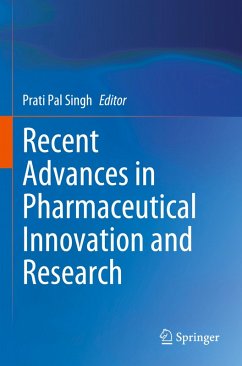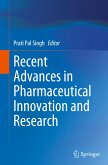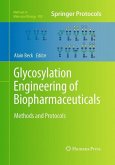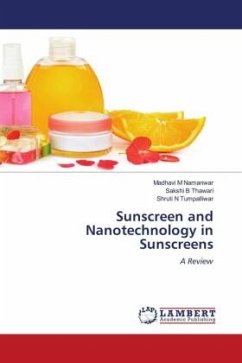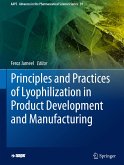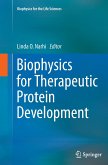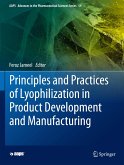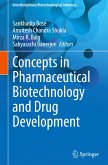Recent Advances in Pharmaceutical Innovation and Research
Herausgegeben:Singh, Prati Pal
Recent Advances in Pharmaceutical Innovation and Research
Herausgegeben:Singh, Prati Pal
- Broschiertes Buch
- Merkliste
- Auf die Merkliste
- Bewerten Bewerten
- Teilen
- Produkt teilen
- Produkterinnerung
- Produkterinnerung
This book covers several important aspects of pharmaceutical research and innovations. It presents important topics on drug delivery, novel microsponge, nanocrystals, polymeric nanoparticles, peptide synthesis, biopharmaceuticals, pharmacodynamics, yeast flocculation, neuromodulators, innovative drug discovery, pharmacoinformatics, aminoquinoline, thiourea crystals for API synthesis, FDCs and formulations research, ayurveda and natural products, and innovations to militate anti-microbial resistance (AMR). A chapter is devoted to the applications of Artificial Intelligence and Machine Learning…mehr
Andere Kunden interessierten sich auch für
![Recent Advances in Pharmaceutical Innovation and Research Recent Advances in Pharmaceutical Innovation and Research]() Recent Advances in Pharmaceutical Innovation and Research149,99 €
Recent Advances in Pharmaceutical Innovation and Research149,99 €![Glycosylation Engineering of Biopharmaceuticals Glycosylation Engineering of Biopharmaceuticals]() Glycosylation Engineering of Biopharmaceuticals90,99 €
Glycosylation Engineering of Biopharmaceuticals90,99 €![Sunscreen and Nanotechnology in Sunscreens Sunscreen and Nanotechnology in Sunscreens]() Madhavi M NamanwarSunscreen and Nanotechnology in Sunscreens29,99 €
Madhavi M NamanwarSunscreen and Nanotechnology in Sunscreens29,99 €![Principles and Practices of Lyophilization in Product Development and Manufacturing Principles and Practices of Lyophilization in Product Development and Manufacturing]() Principles and Practices of Lyophilization in Product Development and Manufacturing120,99 €
Principles and Practices of Lyophilization in Product Development and Manufacturing120,99 €![Biophysics for Therapeutic Protein Development Biophysics for Therapeutic Protein Development]() Biophysics for Therapeutic Protein Development112,99 €
Biophysics for Therapeutic Protein Development112,99 €![Principles and Practices of Lyophilization in Product Development and Manufacturing Principles and Practices of Lyophilization in Product Development and Manufacturing]() Principles and Practices of Lyophilization in Product Development and Manufacturing120,99 €
Principles and Practices of Lyophilization in Product Development and Manufacturing120,99 €![Concepts in Pharmaceutical Biotechnology and Drug Development Concepts in Pharmaceutical Biotechnology and Drug Development]() Concepts in Pharmaceutical Biotechnology and Drug Development112,99 €
Concepts in Pharmaceutical Biotechnology and Drug Development112,99 €-
-
-
This book covers several important aspects of pharmaceutical research and innovations. It presents important topics on drug delivery, novel microsponge, nanocrystals, polymeric nanoparticles, peptide synthesis, biopharmaceuticals, pharmacodynamics, yeast flocculation, neuromodulators, innovative drug discovery, pharmacoinformatics, aminoquinoline, thiourea crystals for API synthesis, FDCs and formulations research, ayurveda and natural products, and innovations to militate anti-microbial resistance (AMR). A chapter is devoted to the applications of Artificial Intelligence and Machine Learning in diverse sectors of the pharmaceutical industry, including drug discovery and development, drug repurposing, and improving pharmaceutical productivity. The book also reviews the role of pharmacogenomics and pharmacogenetics in drug development and precision medicine. Further, the book presents an updated summary of recent advances in the fields of nanomedicines and nano-based drug deliverysystems. This book is useful to pharmaceutical sciences students, researchers, educators, and professionals in the pharmaceutical industry to understand the intricacies of new drug research and innovations.
Produktdetails
- Produktdetails
- Verlag: Springer / Springer Nature Singapore / Springer, Berlin
- Artikelnr. des Verlages: 978-981-99-2304-5
- 2023
- Seitenzahl: 792
- Erscheinungstermin: 13. September 2024
- Englisch
- Abmessung: 235mm x 155mm x 43mm
- Gewicht: 1177g
- ISBN-13: 9789819923045
- ISBN-10: 9819923042
- Artikelnr.: 71736382
- Herstellerkennzeichnung Die Herstellerinformationen sind derzeit nicht verfügbar.
- Verlag: Springer / Springer Nature Singapore / Springer, Berlin
- Artikelnr. des Verlages: 978-981-99-2304-5
- 2023
- Seitenzahl: 792
- Erscheinungstermin: 13. September 2024
- Englisch
- Abmessung: 235mm x 155mm x 43mm
- Gewicht: 1177g
- ISBN-13: 9789819923045
- ISBN-10: 9819923042
- Artikelnr.: 71736382
- Herstellerkennzeichnung Die Herstellerinformationen sind derzeit nicht verfügbar.
Professor (Dr.) Prati Pal Singh, an internationally renowned educationist, scientist, and science writer/editor/communicator formerly worked at the National Institute of Pharmaceutical Education and Research (NIPER), S. A. S Nagar, India. For his Ph. D. degree (1980), he worked at the Central Drug Research Institute, Lucknow, and did postdoctoral research at Stanford University Medical Centre, CA, USA (1986), and The Ohio State University, OH, USA (1984-85). Prof. Singh has been a visiting fellow at the Montreal General Hospital, Montreal, Canada (1985). He is an eminent biotechnologist, parasitologist, microbiologist, immunologist, and neuroimmunopharmacologist. Prof. Singh has worked extensively on the pre-clinical and clinical development of satranidazole, a new anti-amoebic drug now on the market. He first reported opiates as a new class of drugs for the treatment of parasitic/microbial infections and has made seminal contributions to the treatment of malaria, tuberculosis, leishmaniasis, amoebiasis, and trichomoniasis. Prof. Singh has edited/co-edited four books. He has over 200 research publications including one in Nature Medicine, five editorials, and nine patents including one US patent to his credit, and 81 Ph. D. and Master's degrees have been awarded under his guidance. Prof. Singh has been the Editor-in-Chief of the Journal of Parasitic Diseases and is on the Editorial Board of the Journal of Neuroimmune Pharmacology and several other international journals. Prof. Singh has been elected Fellow of The National Academy of Sciences, India (2004) and Fellow of the Indian Academy of Microbiological Sciences (2008), and was nominated for the fellowships of the Indian National Science Academy and the Indian Science Academy. He was elected At-Large Councillor (non-US), Society on Neuroimmune Pharmacology USA in 2010. Prof. Singh has been awarded prestigious the Bill and Melinda Gates Foundation Global Health Award in 2008, the National Institute on Drug Abuse, USA award in 2006, and the Tulasbai Somani Educational Trust Award of the Indian Academy of Neurosciences in 1992. Prof. Singh has been one of the Principal Investigators of the Indo-European Union 7th Framework Programme (2008) collaborative project "New Approaches to Target Tuberculosis". He has been invited to several lectures/official meetings both in India and in the USA, the U. K., Canada, Switzerland, France, Germany, Austria, Italy, Belgium, and China. He has been the Nodal Officer of NIPER, Raebareli, and Member/Chairman of several high-powered Scientific Advisory Committees/sub-committees, various award committees, and selection committees of several institutes. Prof. Singh has been a Senator and Associate Dean (Academic Affairs) of NIPER.
Part 1. Pharmaceutical Innovation and Research.- Chapter 1. Innovation in stabilization of biopharmaceuticals.- Chapter 2. Concepts in pharmacogenomics: tools and applications.- Chapter 3. Pharmacogenetics-a new approach for the selection of the right drug.- Chapter 4. Meeting the unmet challenges of pharmaceutical research using artificial intelligence.- Chapter 5. Pharmaceutical innovation and research in ayurved.- Chapter 6. Ayurveda intervention in perimenopausal syndrome.- Part 2. Drug Discovery and Development.- Chapter 7. Innovative strategies in drug discovery and pharmacoinformatics.- Chapter 8. Advances in peptide synthesis.- Chapter 9. Peptidomimetics in Medicinal Chemistry: The Art of Transforming Peptides to Drugs.- Chapter 10. Diverse Pharmacological Activities of 4-aminoquinoline and its Derivatives .- Chapter 11. Thiourea catalysts for synthesis of active pharmaceutical ingredients.- Chapter 12. The Chemistry and Pharmacology of Mandarin Orange.- Chapter 13. Recent progress in the pharmacology of phytoestrogens: emerging neuromodulators for treating anxiety and depression.- Chapter 14. Next-generation cell-based therapies to combat metastaticbrain tumor.- Chapter 15. Pharmacokinetics and Pharmacodynamics: Fundamentals and Role(s) in Drug Discovery and Development.- Chapter 16. An update on pharmacokinetic models.- Chapter 17. Pharmacodynamics: Basics and Applications in Drug Research.- Part 3. Drug Delivery and Nanotechnology.- Chapter 18. Technological innovations in pharmaceutical drug nanocrystals.- Chapter 19. Fixed Dose Combinations: Innovations and Research.- Chapter 20. Significance of Intranasal Drug Delivery Systems: Recent Trends and Clinical Investigations in Brain Disorders.- Chapter 21. Current challenges and nanotechnology-based pharmaceutical approaches for the treatment and control of visceral leishmaniasis.- Chapter 22. Polymeric Nanoparticles-based Drug Delivery Systems for Anticancer Therapy.Chapter 23. Carbon nanotubes: a review of toxicity and applicability in biomedical applications.- Chapter 24. Recent trends in topical herbal nanotherapeutics for psoriasis.- Part 4. Pharmaceutical Microbiology.- Chapter 25. Antibiotics: past, present, future, and clinical pipeline.- Chapter 26. Innovative strategies to tackle antimicrobial resistance.- Chapter 27. Molecular and mechanistic insights of yeast flocculation.- Chapter 28. Management of hepatitis virus C: current and future treatments.- Chapter 29. Tuberculosis: experimental models, innovations and challenges.- Chapter 30. Targeting outer membrane to tackle multi-drug resistant bacterial pathogens.- Chapter 31. Diphtheria-A Paradigmatic Vaccine Preventable Toxigenic Disease with Changing Epidemiology.- Chapter 32. Emerging and re-emerging infections: an overview.
Part 1. Pharmaceutical Innovation and Research.- Chapter 1. Innovation in stabilization of biopharmaceuticals.- Chapter 2. Concepts in pharmacogenomics: tools and applications.- Chapter 3. Pharmacogenetics-a new approach for the selection of the right drug.- Chapter 4. Meeting the unmet challenges of pharmaceutical research using artificial intelligence.- Chapter 5. Pharmaceutical innovation and research in ayurved.- Chapter 6. Ayurveda intervention in perimenopausal syndrome.- Part 2. Drug Discovery and Development.- Chapter 7. Innovative strategies in drug discovery and pharmacoinformatics.- Chapter 8. Advances in peptide synthesis.- Chapter 9. Peptidomimetics in Medicinal Chemistry: The Art of Transforming Peptides to Drugs.- Chapter 10. Diverse Pharmacological Activities of 4-aminoquinoline and its Derivatives .- Chapter 11. Thiourea catalysts for synthesis of active pharmaceutical ingredients.- Chapter 12. The Chemistry and Pharmacology of Mandarin Orange.- Chapter 13. Recent progress in the pharmacology of phytoestrogens: emerging neuromodulators for treating anxiety and depression.- Chapter 14. Next-generation cell-based therapies to combat metastaticbrain tumor.- Chapter 15. Pharmacokinetics and Pharmacodynamics: Fundamentals and Role(s) in Drug Discovery and Development.- Chapter 16. An update on pharmacokinetic models.- Chapter 17. Pharmacodynamics: Basics and Applications in Drug Research.- Part 3. Drug Delivery and Nanotechnology.- Chapter 18. Technological innovations in pharmaceutical drug nanocrystals.- Chapter 19. Fixed Dose Combinations: Innovations and Research.- Chapter 20. Significance of Intranasal Drug Delivery Systems: Recent Trends and Clinical Investigations in Brain Disorders.- Chapter 21. Current challenges and nanotechnology-based pharmaceutical approaches for the treatment and control of visceral leishmaniasis.- Chapter 22. Polymeric Nanoparticles-based Drug Delivery Systems for Anticancer Therapy.Chapter 23. Carbon nanotubes: a review of toxicity and applicability in biomedical applications.- Chapter 24. Recent trends in topical herbal nanotherapeutics for psoriasis.- Part 4. Pharmaceutical Microbiology.- Chapter 25. Antibiotics: past, present, future, and clinical pipeline.- Chapter 26. Innovative strategies to tackle antimicrobial resistance.- Chapter 27. Molecular and mechanistic insights of yeast flocculation.- Chapter 28. Management of hepatitis virus C: current and future treatments.- Chapter 29. Tuberculosis: experimental models, innovations and challenges.- Chapter 30. Targeting outer membrane to tackle multi-drug resistant bacterial pathogens.- Chapter 31. Diphtheria-A Paradigmatic Vaccine Preventable Toxigenic Disease with Changing Epidemiology.- Chapter 32. Emerging and re-emerging infections: an overview.

